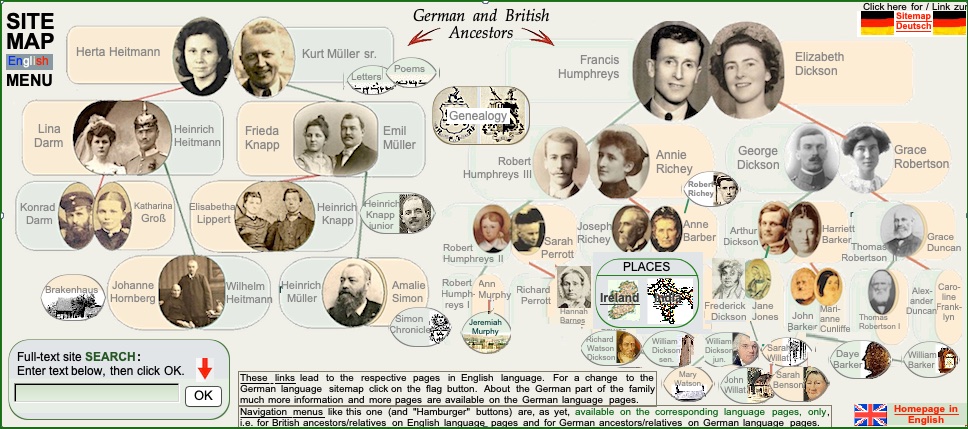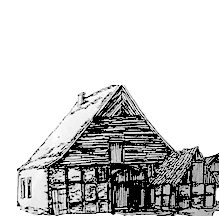born on 9 November 1759 in Warton, England
died September 1824 in London, England
died September 1824 in London, England
© Kurt Müller 2018




Homepage auf
Deutsch
Deutsch




Homepage in
English
English
Homepage
Richard Dickson
Richard Dickson
Richard Watson Dickson was the first child of
William Dickson (I)
and
Mary Watson
and the elder brother of
William Dickson (II)
. He was born at the Watson family's residence, Dale House in Warton, Lancashire, and named after his grandfather
Richard Watson
. The estate
Dale House
seems to exist to the present day, the modern building, though, was erected some 80 years after R.W.Dickson's birth.
born on 9th November 1759 at Dale House,
Warton
, Lancashire, England
died in September 1824 in London, England
Richard W. Dickson was a son of
William Dickson
(I) and
Mary Watson
, the brother of
William Dickson
(II) and the uncle of
George Frederick Dickson
.
The last thing we know about Richard Dickson comes from a newspaper notice regarding his death (see below), saying that his dead body was intended to be kept unburied until resurrection day in a London house which seems to have been prevented by the coroner. There is an extended report about these events to be found in russ McGillivray's biography of R.W.Dickson.

From:

From:
notice of the wedding of R.W.Dickson's daughter Lucretia Margaret and George Russell
R.W.Dickson's daughter Lucretia Margaret married George Russell in the year 1813 at Nairn, Scotland, and 9 months later she gave birth to another George Russell. More children followed.
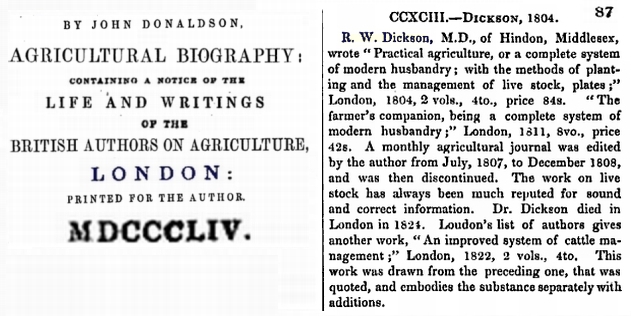
biblio- and biography
From:
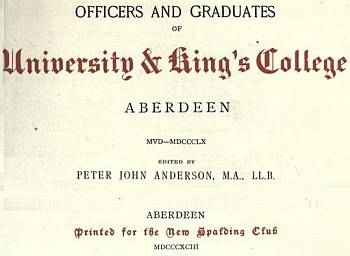
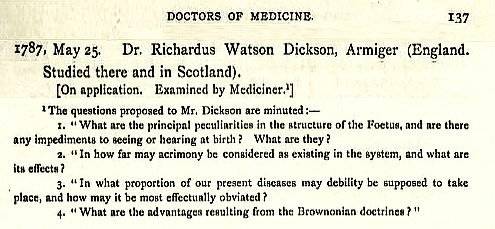

Doctor (MD) at Aberdeen. Even the questions of the examination, led by the mediciner professor Chalmers, are known. The attribute of an "Armiger", according to
Wikipedia, describes "a person entitled to use a coat of arms".
Left and below:
In May 1787, R.W.Dickson took his degree as a Medicinae

From:
Notice of R.W.Dickson's second marriage


Richard Dickson
(
here
a Wikipedia article about him) married his first wife Elizabeth Parkinson* on 16th April 1785 in Preston, Lancashire. From this marriage there were probably no children.
On 24th January 1789 he married his second wife Lucretia Morris in London, Saint Benet Gracechurch and Saint Leonard Eastcheal. The couple had seven children.
* Elizabeth Parkinson was born 19 Oct 1760 Preston and died probably between 1786 and 1789 for which period at Preston the burial records are missing.

Having studied medicine (Medicinae Doctor), R.W.Dickson moved to London where he married his second wife Lucretia Morris in 1789. Russ McGillivray says that "in 1794 Richard was living at Charter House. Charterhouse was an almshouse (a home for gentlemen pensioners), hospital and boys school at Smithfield in London. The hospital was well regarded and it is possible that this reference means that Richard practiced medicine there."
Russ McGillivray continues: "The proximity of Charter House to St. Sepulchre ... suggests that Richard lived there from his marriage to about 1798. He then moved to Hendon, Middlesex, which is part of Greater London, 8 miles north-west of St. Pauls. ... Somehow Richard became an authority on agriculture. According to his cousin Jane Dickson, he had pursued this interest for 35 years, i.e. since about 1789.
In 1802 Richard contributed the section on agriculture in The New Cyclopedia; or Universal Dictionary of Arts and Sciences, by Abraham Rees. According to his cousin, he also contributed a number of articles to The English Encyclopedia: A Collection of Treatises Illustrative of the Arts and Sciences (10 vols), London: G. Kearsley of Fleet Street, 1802."
In the following years R.W.Dickson became an - even internationally - important and very productive author in gardening and agriculture, with a lot of publications - among them voluminous standard works - during the last two decades of his life (see also bottom of page). From about 1815 he was a member of the London Board of Agriculture. A short
overview of his works
is shown on the next page.
However great his merits, his success or even prominence may have become he seems to have been no genius in earning money (or a greater one in spending it). As Russ McGillivray writes: "In August 1812 he was in the King's Bench debtors prison, located in Southwark, south London. Kings Bench had more amenities that other prisons, and was the preferred location for gentlemen insolvents. Most were allowed to live outside the walls of the prison as long as it was within three miles. This is possibly why Richard moved from Hendon to Kent Road in Southwark, near Camberwell, as recorded at the time of his death." The wealth of his wife's family seems to have been no help in this respect because - as Russ McGillivray shows - R.W.Dickson's and his wife
Biography
Richard Watson Dickson




Diese Seite auf
Deutsch
Deutsch
Family history Müller - Humphreys
Though it is predominantly Richard Dickson's voluminous literary and scientific
work
as an author that lives on for posterity, also an increasingly colourful impression of his private life is now emerging from the dark nothing of a remote past. This is mainly due to the skillful historical work being done by his Canadian descendant Russ McGillivray who in his new
biography
(downloadable pdf file) of his ancestor draws a lively picture from what before had been single, dry facts, by smart compilation and new research in depth, by connecting loose ends and creating an integrated whole. Have a look at his interesting
homepage
and his
family tree
! We owe a lot of the information of this page to him though there is much more to be found in his original work.

Above: Portrait of R.W.Dickson by an unknown artist (original in the Museum of the History of Science, University of Oxford)
In 1785 R.W.Dickson married Elizabeth Parkinson from Preston, but already in 1789 he married his second wife Lucretia Morris in London. In the meantime his first wife probably died (the burial records of Preston are missing for this period), and he finished his medical education at Aberdeen, Scotland (1787) after having studied somewhere in England first (see right).
Having studied medicine (Medicinae Doctor), R.W.Dickson moved to London where he married his second wife Lucretia Morris in 1789. Russ McGillivray says that "in 1794 Richard was living at Charter House. Charterhouse was an almshouse (a home for gentlemen pensioners), hospital and boys school at Smithfield in London. The hospital was well regarded and it is possible that this reference means that Richard practiced medicine there."
Russ McGillivray continues: "The proximity of Charter House to St. Sepulchre ... suggests that Richard lived there from his marriage to about 1798. He then moved to Hendon, Middlesex, which is part of Greater London, 8 miles north-west of St. Pauls. ... Somehow Richard became an authority on agriculture. According to his cousin Jane Dickson, he had pursued this interest for 35 years, i.e. since about 1789.
In 1802 Richard contributed the section on agriculture in The New Cyclopedia; or Universal Dictionary of Arts and Sciences, by Abraham Rees. According to his cousin, he also contributed a number of articles to The English Encyclopedia: A Collection of Treatises Illustrative of the Arts and Sciences (10 vols), London: G. Kearsley of Fleet Street, 1802."
In the following years R.W.Dickson became an - even internationally - important and very productive author in gardening and agriculture, with a lot of publications - among them voluminous standard works - during the last two decades of his life (see also bottom of page). From about 1815 he was a member of the London Board of Agriculture. A short
overview of his works
is shown on the next page.
However great his merits, his success or even prominence may have become he seems to have been no genius in earning money (or a greater one in spending it). As Russ McGillivray writes: "In August 1812 he was in the King's Bench debtors prison, located in Southwark, south London. Kings Bench had more amenities that other prisons, and was the preferred location for gentlemen insolvents. Most were allowed to live outside the walls of the prison as long as it was within three miles. This is possibly why Richard moved from Hendon to Kent Road in Southwark, near Camberwell, as recorded at the time of his death." The wealth of his wife's family seems to have been no help in this respect because - as Russ McGillivray shows - R.W.Dickson's and his wife Lucretia separated or even had something like an official divorce.
At the end of his life he lived at Kent Road in Southwark with his cousin Jane Dickson who seems to have been extremely committed to him and his work. After his death she started an extended public discussion about R.W.Dickson's merits which state and public allegedly failed to recognize. As an expression of her protest and for exerting pressure she left his unburied corpse in her flat for months. All these events are described and documented in detail by
Russ McGillivray
in his fabulous
biography
of R.W.Dickson.


Menu



